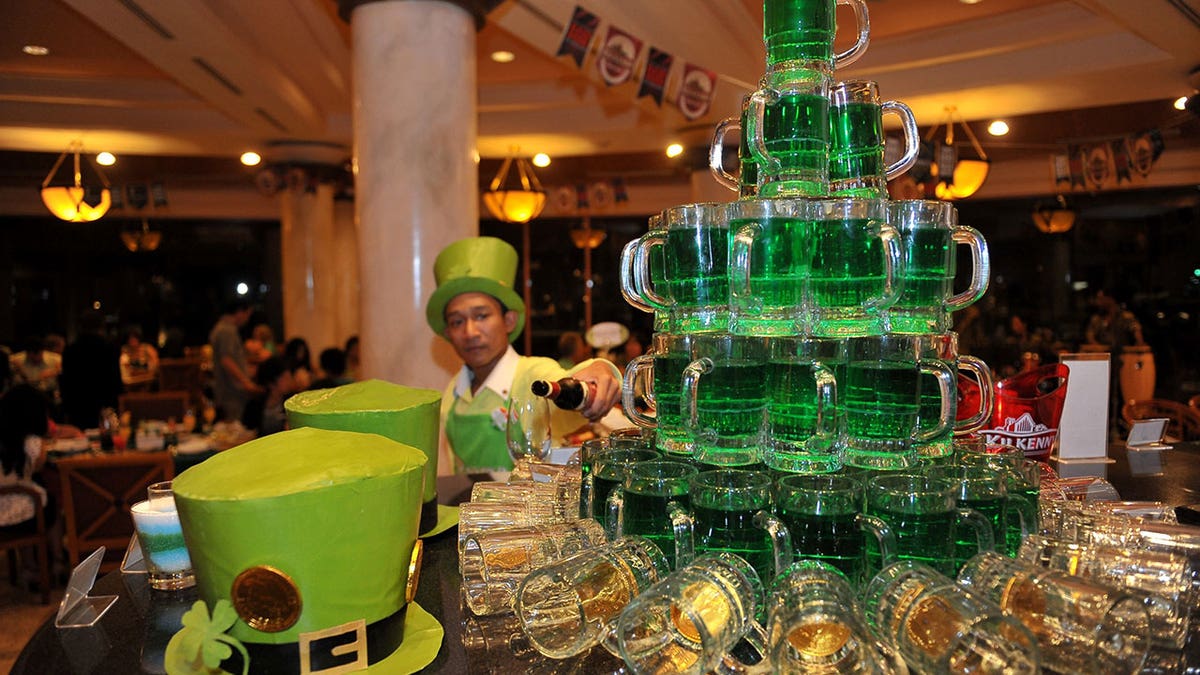'Fox & Friends' celebrates St. Patrick's Day with Black Tap
Restaurant chain shows the 'Fox & Friends' hosts how to make a 'Luck of the Irish' crazy shake.
St. Patrick's Day is typically filled with lively Irish music, festive parades and delicious food.
Even if you partake in St. Patrick's Day fun, there are a lot of surprising facts you may not know about the occasion.
On St. Patrick's Day, you'll see people decked out in green, but did you know St. Patrick often wore blue? Another Patty's Day staple is corned beef and cabbage, which didn't come from Ireland.
It was born right here in the United States.
Read on for more fun facts about St. Patrick's Day.

St. Patrick's Day is one of the biggest drinking days of the year. (Robertus Pudyanto/Getty Images)
- St. Patrick’s Day used to be a religious feast day
- St. Patrick was from Britain
- St. Patrick’s birth name was Maewyn Succat
- The first St. Patrick’s Day parade was in the United States, not Ireland
- St. Patrick’s most revered color was blue, not green
- Corned beef and cabbage started in the United States
- St. Patrick’s Day used to be a dry holiday
- There were no snakes to banish
1. St. Patrick’s Day used to be a religious feast day
While the day still does have religious ties, it has become more about Irish pride and heritage than religion.
The St. Patrick’s Day celebration dates back to the ninth or 10th century, according to History.com. The day celebrated Saint Patrick, the patron saint of Ireland.
March 17 marks what was known to be the day he died.
ST. PATRICK'S DAY FOOD: TIPS FOR MAKING THE PERFECT CORNED BEEF AND CABBAGE FOR YOUR IRISH FEAST
Since St. Patrick was a Christian who brought the religion to Ireland, the day was a religious celebration.
2. St. Patrick was actually from Britain
Did you know St. Patrick wasn’t from Ireland? The story of St. Patrick, according to History.com, is that he lived in the fifth century and was enslaved as a teenager. He was taken from Britain to Ireland, but he escaped.
He later returned to Ireland as a missionary to bring Christianity to the native people.
3. St. Patrick’s birth name was Maewyn Succat
Although many of the details of his life are not known, according to Biography.com, his birth name was Maewyn Succat.
He later changed his name to Patricius or Patrick when he became a priest, according to Time magazine.
4. The first St. Patrick’s Day parade was in the United States
Ireland was not the first to hold a St. Patrick’s Day parade. It was actually held in the United States.
Records reveal the first parade took place in what is now St. Augustine, Florida, in 1601, according to History.com.

The Chicago River is dyed green for St. Patrick's Day. (Scott Olson/Getty Images)
The New York City St. Patrick's Day parade became a huge celebration in the U.S. beginning in 1762.
5. St. Patrick’s most revered color was blue, not green
Green is now the color of St. Patrick’s Day, but St. Patrick wore blue. Early representations of St. Patrick show him wearing blue clothing, according to Smithsonian Magazine. If St. Patrick’s official color was blue, why is green the color associated with the day?
There are a few different theories.
The first theory is connected to Irish folklore, which says wearing green makes one invisible to leprechauns who like to pinch, according to National Geographic. To avoid being pinched, green is worn.
Another reason green is displayed across the world on St. Patrick's Day is because of the green in the Irish flag.
6. Corned beef and cabbage started in the United States
The traditional corned beef and cabbage meal served on St. Patrick's Day started in the U.S., not Ireland.
CORNED BEEF AND CABBAGE ON ST. PATRICK'S DAY MAY SERVE UP SOME NUTRITIOUS BENEFITS
Corned beef was eaten by Irish immigrants when they came to the United States.
A more traditional meal eaten in Ireland is bacon and cabbage or a beef stew.

Corned beef and cabbage is a favorite for St. Patrick's Day. (iStock)
7. St. Patrick’s Day was once a dry holiday
St. Patrick’s Day today is one of the most popular drinking days of the year, but that wasn’t always the case.
This was because of the religious origins of the day, according to Good Housekeeping. Since it was a religious holiday, pubs were closed.
CLICK HERE TO SIGN UP FOR OUR LIFESTYLE NEWSLETTER
It wasn’t until the late 1970s that it changed.
8. There were no snakes to banish
Legend has it St. Patrick himself banished all snakes from Ireland, according to History.com.
Science doesn't quite back up that story, as there were no signs of snakes in the country's fossil record, according to the source.
CLICK HERE TO GET THE FOX NEWS APP
Before Ireland became surrounded by water, it was covered in ice, according to History.com, and that icy atmosphere would have been far too cold for slithering snakes.
For more Lifestyle articles, visit www.foxnews.com/lifestyle.

